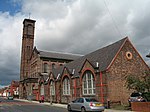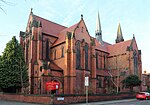Smithdown Road
Streets in LiverpoolStudent quartersUse British English from February 2017

Smithdown Road is a historic street in Liverpool, England, which now forms part of the A562. The area was previously known as Smithdown (Esmedune or Smeedon in Olde English) and dates back to 1086 when it was listed in the Domesday Book. The causeway that actually became what is now Smithdown Road emerges in documentation around 1775. It is currently the location of Toxteth Park Cemetery, Wavertree Playground and was previously the location of Sefton General Hospital, known as the Smithdown Hospital and before that the Old Workhouse.
Excerpt from the Wikipedia article Smithdown Road (License: CC BY-SA 3.0, Authors, Images).Smithdown Road
Smithdown Road, Liverpool Wavertree
Geographical coordinates (GPS) Address Nearby Places Show on map
Geographical coordinates (GPS)
| Latitude | Longitude |
|---|---|
| N 53.39519 ° | E -2.93889 ° |
Address
SMITHDOWN RD/GRANVILLE RD
Smithdown Road
L7 4JQ Liverpool, Wavertree
England, United Kingdom
Open on Google Maps







